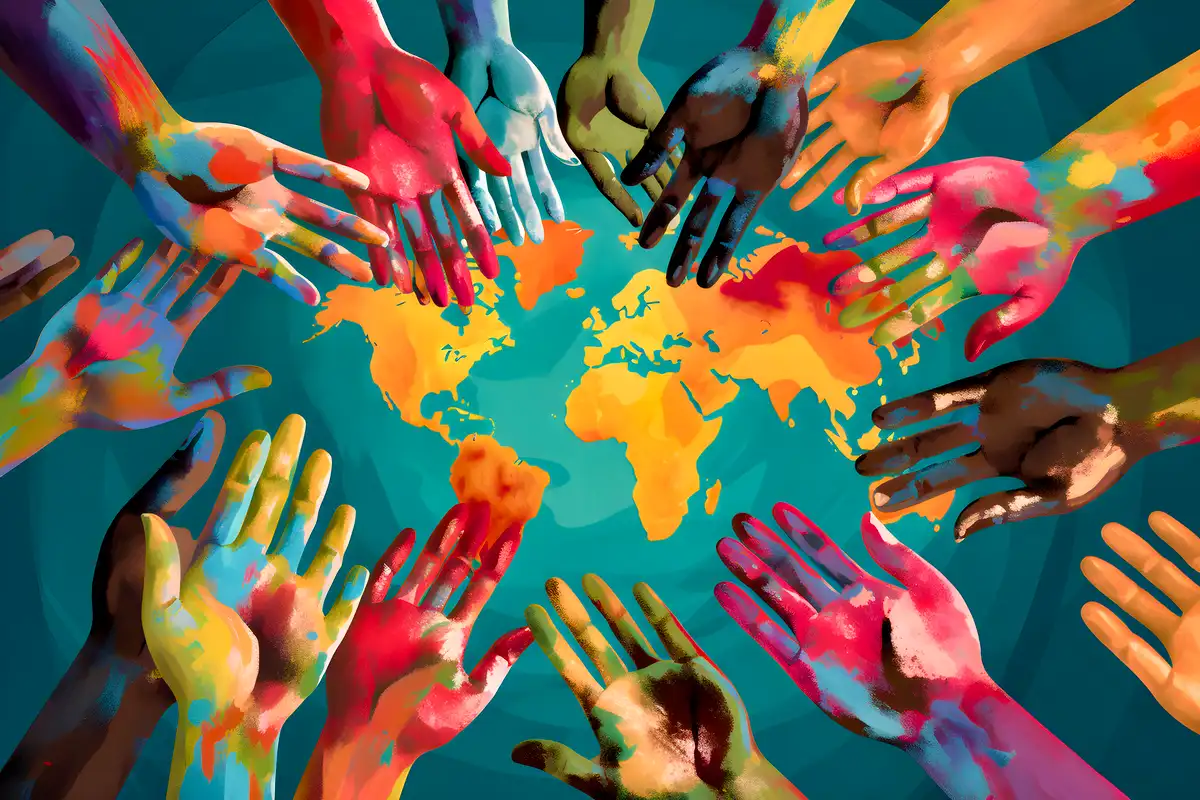Inclusive Presentations
42 ways to be more inclusive
Over the past 5 years our Powerful Presentations Course has been one of our most popular with many of the big organisations we’ve partnered with around the world.
We’ve worked really hard to make our slides and delivery as inclusive and accessible as possible and as corporate trainers for over 15 years we’ve been developing and applying what works. So we wanted to share that with everyone.
We’ve curated a selection of ideas, currently 42 organised into 5 categories, to help you be more inclusive in your presentation design & delivery. Each and every one could make a big difference to someone’s life!
Give Me a K.I.S.S.
Keep It Super Simple!
Slides are not documents. Less is more. You get the idea!
Text heavy slides are not only visually unattractive, they are often confusing and difficult to follow.
Keep text to a minimum and use images and other visuals to support your point.
Stick to one main point per slide and make your presentations more impactful and easier to follow.
Size Matters!
Whatever your preference, when it comes to visibility, bigger IS better!
Use larger font sizes to make sure everyone will be able to read them.
Things look way smaller at the back of a room or on a small screen and for a person who is visually impaired it could be impossible.
A font size no smaller than 24 points is a good rule. For data, then 18 points is your absolute minimum.
Better the Devil You Know
When preparing for a presentation it’s essential you consider your audience.
What’s their level of knowledge about the topic? What thoughts & questions might they have? What language would make the message clear for everyone.
Looking at the presentation from their perspective will help you adapt your structure, design and delivery so it has more impact and is inclusive for all.
Expect the Expected
Set expectations up front. Outline what you’ll be covering and what you need from your participants.
For some, attending a presentation requires a lot of focus or could cause anxiety. Are there activities? Opportunities for questions? Time for reflection? Comfort breaks?
The more you define up front, the more people can relax, knowing what to expect and what is expected of them.
Stereo-atypical
Do some of your photos depict a kind of stereotype?
It’s not only about what comes out of your mouth or the words you use, it’s also the media you share.
Thankfully there are plenty of stock photo & video libraries with people of different races, ages, genders and more in all sorts of situations.
So shake it up and remember that representation matters!
Once Upon a Time…
Beginning, middle and end. Sounds obvious right? Too often presentations lack an attention grabbing start and an impactful finish.
A well structured presentation is much more engaging and memorable.
It will also help people stay focused and make it easier for them to understand your message.
Focus on 2 or 3 main points. If it’s not essential then why is it there?
A Picture is Worth…
Who’s heard of the Picture Superiority Effect? It’s the phenomenon where people remember pictures better than they remember the corresponding words.
Use a combination of words and pictures to simplify your slides and make your presentation much more memorable.
When the image is part of your story, remember to describe it rather than assume everyone can see it clearly.
Luke, I Am Your Father
You might know that quote but not everyone will. When using pop culture references, don’t expect everyone to understand, so plan for that.
Be mindful, if someone doesn’t know the reference, it can easily lead to misunderstandings and to people feeling excluded.
Make it work for someone who hasn’t watched that movie or read that book and explain the reference, it’s relevance and intention.
Smoke & Mirrors
Swish, zoom, bang! We get it, you really know how to use PowerPoint but keep slide transitions and animations simple.
Fast and complicated animations can be distracting and annoying for your audience and in some cases they can trigger nausea, headaches and dizziness.
Avoid using animations just for the sake of it. A simple fade is perfect for building a slide or a transition.
I Don’t Exist!
Inclusive presentations are about considering your audience and making sure they can relate to what is being shown and said.
When your audience feels they’re being represented, they are more likely to engage and your message will resonate more clearly.
Try to represent different genders, races, cultures, disabilities, sexualities and socio-economic groups in your presentation with a variety of pictures, videos and stories.
Q&A ccessible
Not everyone can or wants interact with you in the same way as everyone else.
Include different ways for your audience to participate and ask questions. Online tools now offer polls, word clouds and other great options for people to share their opinion and interact.
Just because you can hear or read the comments, don’t assume everyone else can. Repeat them so you are sure everyone’s got it.
You’re Beautiful
Many people want to see you, not only because you’re gorgeous (you know you are!) but for some they want to read your lips to understand you better.
Be mindful of where you stand, how visible your face is and stop looking at the presentation! Focus on your audience and connect with them.
This will help make your presentations even more engaging for everyone.
Just Keep Swimming
It’s no surprise that our attention span has reduced in the last few decades, so stick to the point and keep it punchy.
People with attention deficiencies may take longer to read slides and struggle to listen to what you’re saying at the same time, so simple slides are key!
Building in objects on more complex slides can help keep your audience engaged and focused.
* reference from the front of the card
Icebreakers, not Mood Breakers!
Some of your presentations might include icebreakers or team activities. Great!
But are they inclusive and will everyone feel comfortable participating?
Take into account different physical, mental and learning disabilities as well as cultural differences.
Ask the group before you get started and have a Plan B in case you need to adapt some of your activities on the fly.
Think Before You Speak
Mental illnesses are not adjectives! Don’t use mental health terms to describe how you or someone is feeling.
Terms like bipolar, OCD and PTSD are names for real psychiatric conditions, using them as adjectives can undermine their impact on people.
Words like mental and crazy can be harmful and stigmatising when used improperly. Try replacing normal with usual or typical.
Sharing is Caring
Sharing your slides beforehand enables your audience to follow along at their own pace or adapt the presentation on their own devices.
For example, people with visual disabilities can zoom in or follow along on braille displays or with a screen reader and earbuds.
You can share slides and complimentary materials, by including links to these on your first slide and mention it in your introduction.
Mind Your Language
Is the language you’re using inclusive or not?
Gender bias is still common in everyday conversations, so let’s do our bit to change that.
We often hear “hi guys” and we get it, it can be hard to change some habits.
A simple thing you can do, is to use gender neutral terminology.
Here are a few ideas; “hi folks”, “hi team” or “hi everyone”.
Stand Out From the Crowd
You can control your slides, but not your environment.
Contrast might look fine on your computer screen but how will it look on a projector, or screen adapted to someone who is visually impaired?
Use bold colours that make your text stand out clearly from the background. Even better, use a colour contrast checker and aim for a ratio of at least 4.50.
Loud and Proud
Be proud, but not too loud. Find the right balance and make sure everyone at the back of the room can hear you.
If available, a microphone will help you better project your voice and many venues offer induction loops that connect to hearing aids.
If you have any video or audio clips in your presentation make sure to test the volume beforehand and turn on those captions.
Don’t Go Full Unicorn
Unicorns are cool but don’t let them throw up on your slides!
Very colourful slides can be hard to read and understand.
Use colour meaningfully to make a point and to highlight important information.
| Limit yourself to 3 colours: a high contrast colour for your main text, a more vibrant colour for important words and phrases and a subtle colour for design elements like this box. |
Caption This!
If someone couldn’t hear your presentation, would they still be able to follow along?
A sign language interpreter is a great option, if available.
Use technology to your advantage. Did you know PowerPoint offers live captions for presentations? Incredible, right!
Most popular video conferencing platforms now also offer live captioning in multiple languages, so let participants know.
NSFW
KPI, ROI, OMG! We all love a good acronym, but who are you excluding when you use them? Remember, you were the newbie once.
This also applies to jargon and technical language, so keep it simple and inclusive.
These terms can make you feel like an insider but also an outsider too!
Consider your audience and check if they understand but don’t make assumptions that they do.
What Are You Talking About?
“You know that feeling, when you hear your alarm clock, jump out of bed, run out the door and sprint to catch the train. We’ve all been there!”
Stories are the perfect way to connect with your audience emotionally but not everyone can relate.
Be mindful that we don’t all experience things in the same way, so ask them for some of their stories too. You’ll be surprised what you hear!
Ready? Steady. Go!
Testing, 123! There is nothing wrong with asking your audience if they can hear and see you and your presentation before you begin. We’d encourage it.
Start your presentation by making sure that everyone is ready and able to participate and if there are any questions before you begin.
Some people might be using their own devices and technology to follow along, so don’t assume they are checking their social!
Crystal Clear
Don’t be hard to read! When it comes to fonts, remember legibility before aesthetics.
Some fonts can be super cool and funky, but how easy are they for people to read?
Sans serif fonts are typically top of the list for their clarity and legibility.
Too many fonts can also make it difficult to easily move through the content. Use up to 3 different fonts max!
SEE WHAT WE MEAN!
Slower Than the Speed of Turtle
Slow down, pause & breathe. Most of us speed up when presenting, which can make it harder for people to follow along.
Be mindful of varying your pace and if you’re using slides, give us time to digest the content before you move on.
The first 30 seconds of speech are particularly important too, as people are adjusting to your voice, tone and accent.
Work in Progress
Feedback is a gift. Yes, it’s a cliche, but it’s true!
What better way to improve your presentations and make them more inclusive than by collecting feedback.
When asking for feedback, include a couple of questions about how inclusive your presentation was and what suggestions participants have to make it more accessible for everyone.
This also demonstrates empathy and a desire to learn.
Peace and Love
Merry Christmas! Sorry I meant happy holidays!
Some gestures, words and images can hold very different meanings to different cultures.
With our audiences becoming more and more diverse and eclectic, it’s important to be mindful about who they are, their cultural differences and make everyone feel included.
Think about it, even “Happy Friday” could be annoying if you work on Saturday.
Showtime
An interactive demo is a great way to spice up a presentation, unfortunately they often end up being more confusing than enlightening.
Describe everything you’re doing + where you are on the screen + make your cursor bigger + slow right down + regularly check your audience is following along + keep it short.
Check out one of our demos to get you inspired.
As You Can See…
Imagine you are Blind and you’re attending a presentation surrounded by people you don’t know. The presenter goes silent for a few seconds and everyone starts laughing!
How would you feel? Luckily the presenter remembers that not everyone might be able to see and they say: “I’ve just shown a funny image of…”
Make sure everyone is included by describing relevant information on your slides.
Take the Test
PowerPoint offers great tools to make your presentation easier to follow and more accessible.
One of our favourites is the Accessibility Checker.
Head to the review tab in the ribbon on the upper section of the app and click on the “Check Accessibility” button.
A new panel on the right will open to suggest changes you can apply right there.
This is a powerful tool you’ve already got, so see if you pass!
First, Person first
Using the right terminology is key to making your audience feel welcome and included.
When it comes to referring to people with disabilities a good place to start is to use person first terminology.
E.g. A person with a visual impairment instead of a blind person.
Terminology might vary in different countries and is constantly evolving, so try to keep up to date.
Ha Ha… Not
Humour is a great way to get people’s attention, raise energy levels and connect with your audience.
However, one small joke also has the power to alienate your audience and destroy the atmosphere.
If someone recorded your presentation and posted it online, would some people find your humour offensive?
If yes, then maybe keep it for your open mic night.
No Girls Allowed
“Who’s that girl over there?” “That’s the Finance Director and she’s really feisty…”
The way we describe women in the workplace is often quite different from men. Words like girl, bossy and feisty change the way we view women, even unconsciously.
When women are called girls, intentionally or unintentionally, the subtle message is that they’re not mature, professional or responsible.
So, let’s call women, women!
Short and Sweet
Long links suck! They’re a pain to type and impossible to say!
When sharing links make sure they are short & easy to type.
Read them out loud, paste them into the chat and include a QR code too.
Use a URL shortener to shorten them and maximise readability and hear-ability by customising the short link to contain words rather than random letters and numbers.
WARNING!
Viewer discretion is advised! This video contains flashing sequences that may potentially trigger seizures for people with photosensitive epilepsy.
It’s more likely that your boring data presentation will induce sleep than seizures, however in some instances flashing images and videos can also trigger nausea and dizziness.
If you do really need to show these sort of videos and images, make sure to add a warning before.
Non Binary Code
Wouldn’t it be great if we had one word that encompasses everyone without making any gender assumptions?
Oh wait, we have one: THEY!
Being misgendered or misnamed may leave a person feeling disrespected, invalidated and humiliated.
With a bit of practice and awareness something that requires little effort from us can make a huge difference to others.
No Graph-iti
Convoluted charts and tables can be difficult to digest and very confusing for many people and boring too!
If you really need to show large amounts of data to make a point or support your message, then keep it simple.
Share the top level first and then move on to the more complex charts and tables.
Remember, your job is to show us your insights, so focus on the story behind the data.
Don’t Talk Over Me
It might be tempting to have some quiet music playing in the background while you present, don’t!
Some people might hear okay and even enjoy it while you speak over music.
Others can find it very distracting and may struggle to focus on what you’re saying.
If you play any audio or video and want to comment about it, pause it before you speak.
Not Everyone Sees Red
Bear in mind that not everyone sees colour in the same way.
There are over 300 Million people in the world who are colour blind. Mainly men in fact, about 1 in 12.
Don’t rely solely on colour to make your point. Instead use a combination of colour, labels, patterns and be more descriptive.
“In section 4, the red circle in the top left corner…”
Introvert Alert
People who are more introverted might be less likely to raise their hand and participate in large presentation settings.
What can you do to encourage them to participate?
Offer the option to ask questions online or to send them in advance. Give people reflection time and try working in smaller groups.
Encourage without being pushy, listen actively and don’t interrupt.
You’re Not Done Yet!
You’ve finished your presentation, congrats! It’s good practise to share your presentation afterwards.
Check your slide order and number them, add any details that are missing without the presenter and consider including your presenter notes too.
Then check the slides are accessible; alt text for images, captions for videos and all the good stuff we’ve shared with you in this inclusive presentations collection.











